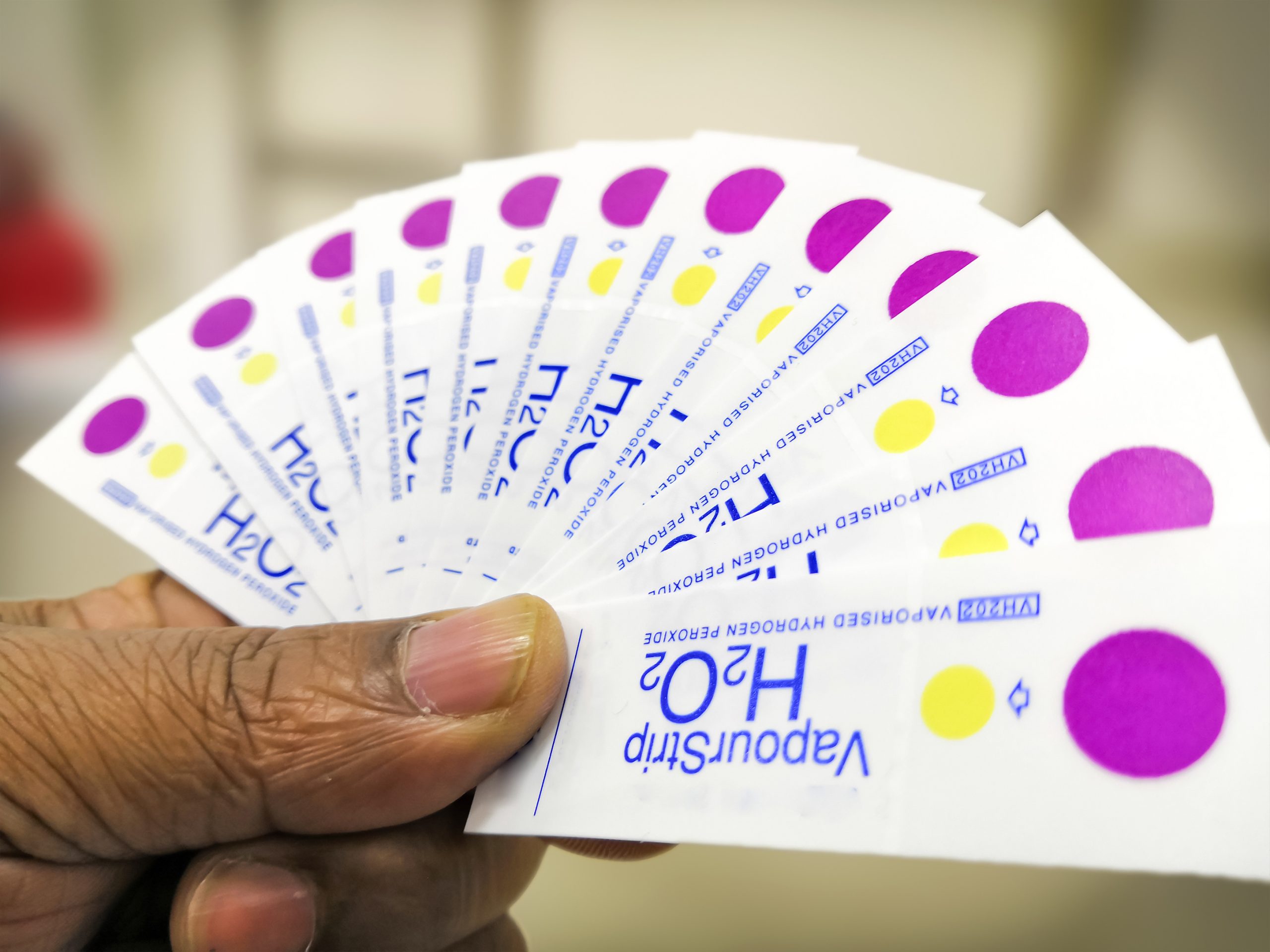
Chemical indicators have been used for decades to validate sterilisation and decontamination parameters and to ensure that the process has met the standard required for such procedures.
However, there aren’t many published materials on their efficacy in delivering or providing accurate results. We have delved into PubMed and Web of Science libraries to acquire more understanding of hydrogen peroxide chemical indicators and their effectiveness to validate sterilisation/decontamination cycles and parameters.
How do chemical indicators work?
The chemical indicators process is quite simple. It consists of a strip that changes colour due to a chemical reaction. In this case, it is usually one of the sterilisation parameters reacting with the reagent on the strip causing a chemical reaction and a change colour of the strips that can be seen with the naked eye. Scientifically, such a simple method shouldn’t be considered a universal standard of testing.
This test has been discussed in a few papers and has been mentioned by the Centers for Disease Control and Prevention (CDC) and the International Organization for Standardization (ISO). However, it seems that there is a very limited number of peer-reviewed articles evaluating the efficacy of those chemical indicators. Chemical indicators are available in the markets on large scale, but a very limited number of studies actually assessed the efficacy of these chemical strips.
The available literature seems to suggest that chemical indicators have been almost exclusively designed to be used in sterilisation systems. Perhaps that is not surprising, as this is where chemical indicators have a good practical use. A good example would be that chemical indicators can show, when affixed on to the outside of each pack, that the package has been processed through a sterilisation cycle, but these indicators do not prove sterilisation has been achieved.
They indicate successful cycles at marginal sterilisation time. However, if a chemical indicator is not used in the controlled cycle that is intended for, the chemical indicator manufacturer would have no evidence to suggest that the cycle had been effective – as the chemical indicator is indicating the presence of a chemical, not measuring the dose precisely, or the conditions of exposure, the intensity over time, or other key environmental conditions such as temperature and humidity which effect the efficacy. More importantly it doesn’t show if pathogens are killed. This is inferred from assuming that the properly controlled cycle has taken place.
According to ISO 11140-1:2014 document for hydrogen peroxide chemical indicators, the following critical process variables are defined as being critical: temperature, humidity and hydrogen peroxide concentration. However, it is known that these variables cannot be measured through a chemical indicator and the fact that ISO emphasises the importance of these process variables in influencing the efficacy of results.
Are chemical indicators efficient?
In one study by Rutala and colleagues (1993), they investigated the efficacy of three different types of indicators: Rapid biological indicator, 3 conventional biological indicators and three chemical indicators on steam sterilisation. Their conclusion was that the rapid biological test was equivalent to the 24-hour biological indicator in terms of efficacy and results, but chemical indicators were too sensitive to the processing conditions (e.g., steam) and are inadequate to ensure effective sterilisation.
Even though this study was based on flash sterilisation, the same concepts can be applied for VHP decontamination, as all chemical indicators share the same mechanism of action (strips change colour as a result of chemical reactions). Therefore, chemical indicators should not be used to ensure effective sterilisation or decontamination.
According to the literature, biological indicators are the only process indicators that directly monitor the lethality of a given sterilisation process, suggesting the vulnerability of chemical indicators to inaccurately deliver correct readings. Therefore, it has been suggested that chemical indicators calibration alone is not adequate to ensure decontamination and sterilisation parameters have been met.
According to CDC, chemical indicators alone are not efficient enough to ensure that decontamination parameters have been met, and testing should always be done in combination with biological indicators as the gold standard, suggesting that chemical indicators alone can give rise to false-positives and inaccurate results. It is easy to see why it gets quite complicated when an attempt is being made to adopt these chemical indicators in whole room decontamination cycle validation.
All mentioned reliability issues are amplified by the conditions of the decontamination process and the nature of whole room decontamination systems.
So, what is the alternative to chemical indicators?
Electronic indicators are the best alternative to chemical indicators. Modern vaporising hydrogen peroxide decontamination systems give very consistent results – because they are controlled by a range of electronic sensors. The combination of these sensors forms an electronic indicator – a set of sensor readings over time which show that the decontamination parameters are met.
Electronic indicators monitor and adapt the injection of hydrogen peroxide solution to deliver a standard decontamination cycle which has been validated against biological indicators in extensive trials. Where the standard cycle conditions have been achieved as validated by the electronic indicator, or more importantly if this is not the case – the system can display this to the operator. The full cycle history can be logged for later audit and continuous monitoring.
Any reduction in performance can be investigated and ideally addressed without the system failing to meet standard cycle conditions when it is required. Logically, automated technological monitoring from these electronic indicators would anytime replace a manual reading from a strip or a paper which is the case for chemical indicators.
In addition, electronic indicators have a far more comprehensive approach to the control of a decontamination cycle. They can monitor starting conditions which might affect efficacy, such as humidity or temperature. They can monitor conditions during the cycle, measuring the concentration of the biocides that have been dispensed. They can control the precise time of exposure and stop the timer and adjust conditions if required.
They can also monitor other components of the system operation, like fans for dispersing the biocide solution. Each aspect of the cycle that is monitored and controlled is required to deliver the cycle which has been proven, through trials with biological indicators, to work. This gives a much greater degree of confidence that cycle conditions have been met and makes the inference, that pathogens have been killed in the required numbers, much stronger than with chemical indicators alone.
Although there is not much published literature on the efficacy of chemical indicators, it has been reported several times that chemical indicators do not ensure full sterilisation and may give rise to false positives.
Chemical indicators can be useful when used as supplementary measure and shouldn’t be considered as a way of determining the efficiency of a sterilisation or decontamination process.
Sterilisers and decontamination devices can be equipped with electronic indicators (monitoring systems) that actually have been proven to provide better results than chemical indicators. Also, whole room decontamination systems should by design be able to determine the success of the cycle, and the chemical indicators could be used as a supplementary measure i.e. show gas penetration into occluded space. The findings of this literature review give rise to the idea that chemical indicators aren’t optimal in delivering the correct results measuring critical variables that influence efficacy of results.


